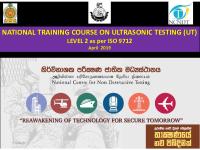IELTS (International English Language Testing System) - BOOK-REVIEW [PDF]
REVIEW BOOK 1 BY : FITRIA ULFA/12267 K1/2009 TITLE : IELTS : International English Language Testing System YEAR : 200
34 0 274KB
Papiere empfehlen
![IELTS (International English Language Testing System) - BOOK-REVIEW [PDF]](https://vdoc.tips/img/200x200/ielts-international-english-language-testing-system-book-review.jpg)
- Author / Uploaded
- Fardhi Afindra Putra
Datei wird geladen, bitte warten...
Zitiervorschau
REVIEW BOOK 1 BY : FITRIA ULFA/12267 K1/2009 TITLE
: IELTS : International English Language Testing System
YEAR
: 2003
PUBLISHER: UNIVERSITY of CAMBRIDGE ESOL EXAMINATION
CHAPTER 1 IELTS Test Results
Marking is carried out at the test centre by trained examiners whose work is closely monitored. This ensures that test results are available without any administrative delay.
Test Scores : A score is reported for each module of the test. Overall Band Scores and Listening and Reading scores are reported in whole and half Bands; Writing and Speaking Band Scores are reported in whole Bands only.
Test Report Form : Each module is reported separately as a Band Score, together with an Overall Band Score reported as a whole band or a half band. The completed Test Report Form bears a centre stamp, a validation stamp, the candidate’s photograph.
Interpretation of Results : Assessment of performance in IELTS depends on how the candidate’s ability in English relates to the language demands of courses of study or training, not on reaching a fixed pass mark.
CHAPTER II TEST MODULES
Each candidate takes four IELTS test modules, one in each of the four skills, Listening, Reading, Writing and Speaking. Listening :
Duration and format :The Listening Module takes around 30 minutes. There are 40 questions. There are four sections.The Listening Module is recorded on a tape and is played ONCE only.
Task types : The first two sections are concerned with social needs. There is a conversation between two speakers and then a monologue
Marking and Assessment : One mark is awarded for each correct answer in the 40 item test.
Reading :
Duration and format :The Reading Module takes 60 minutes. There are 40 questions, based on three reading passages with a total of 2,000 to 2,750 words.
Task Types :A variety of questions are used, chosen from the following types: multiple choice , short-answer questions, sentence completion, notes/ summary/ diagram/ flow-chart/ table completion, choosing from a ‘heading bank’for identified paragraphs/sections of the text, identification of writer’s views/ claims –yes, no or not given, identification of information in the text –yes, no or not, given/true, false or not given, classification, matching lists/ phrases.
Writing :
Duration and format : The Writing Module takes 60 minutes. There are two tasks to complete. It is suggested that about 20 minutes is spent on Task 1 which
requires candidates to write at least 150 words. Task 2 requires at least 250 words and should take about 40 minutes.
Task Types : Academic Writing In Task 1 candidates are asked to interpret a diagram or table, and to present the information in their own words. In Task 2 candidates are presented with a point of view or argument or problem.
Speaking :
Duration and format : The Speaking Module takes between 11 and 14 minutes and consists of an oral interview between the candidate and an examiner.
Task Types : There are three main parts. Each part fulfils a specific function in terms of interaction pattern, task input and candidate output.
Marking and assessment : based on Fluency and Coherence, Lexical Resource, Grammatical Range and Accuracy, Pronunciation.
CHAPTER III Test Registration and Administration
Most centres conduct a testing session at least once a month and more often at peak times. Special test sessions can be arranged for particular sponsors or institutions. Individual test centres should be contacted for their current programmes. The chart below shows the test procedure for candidates. Enquarry – application – confirmation – day of the test – results Transferring answers to the Answer Sheet : Candidates are required to transfer their answers to an Answer. Sheet for the Listening, Academic Reading and General Training. Reading Modules. Ten minutes extra time is allowed for transferring answers at the end of the Listening but not for the Reading. The Answer Sheet is double-sided; candidates write their Listening answers on one side and then turn over and write their Reading answers on the other side. After marking at centre all Answer Sheets are returned to Cambridge ESOL for analysis.
CHAPTER IV Special Circumstances
Test centres make every effort to cater for the special needs of any disabled candidates, to enable them to best understand questions and tasks and give their answers. Candidates with visual difficulties may apply for a range of provisions, including enlarged print, and brailled question papers. If candidates suffer from partial hearing loss and can hear with the help of headphones or special amplification equipment they may ask for permission to use this type of equipment when taking listening modules. If candidates have dyslexia or another specific learning difficulty, they may need extra time to complete a paper. If a candidate is genuinely ill during the test it should be brought to the attention of the test supervisor.
CHAPTER V Development and Research
IELTS test material is developed by Cambridge ESOL using the following stages: • Commissioning • Editing • Pretesting • Analysis and banking of material • Standards Fixing • Question paper construction Throughout the writing and editing process, carried out simultaneously in Australia, New Zealand and the UK, strict guidelines are followed in order to ensure that the materials conform to the test specifications.









